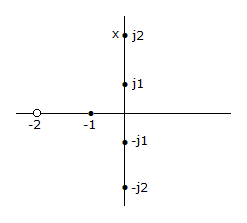Electronics and Communication Engineering - Automatic Control Systems - Discussion
Discussion Forum : Automatic Control Systems - Section 1 (Q.No. 47)
47.
The given figure shows a pole zero diagram. The transfer function G(j1) is


Answer: Option
Explanation:
Join j1 point with the zero and poles. Find magnitude and phase angles of all these lines.
Discussion:
7 comments Page 1 of 1.
Pavan said:
8 years ago
(s^2+4) will give 2j as one of the pole mentioned by Ahmed and (S^2+1) will j as pole
j=√(-1) --------> formula.
j=√(-1) --------> formula.
Fatima said:
8 years ago
[(s^2+4)(S^2+1) how we obtained these 4 poles?
Kajal said:
8 years ago
The transfer functio is (s+2)/[(s^2+4)(S^2+1)(S+1)].
The magnitude is 2/4=0.5 ;when put w=0.
The angle is tan^-1 (w/2) - tan^-1(w)=0 ; when put w=0.
The magnitude is 2/4=0.5 ;when put w=0.
The angle is tan^-1 (w/2) - tan^-1(w)=0 ; when put w=0.
Anshul Joshi said:
9 years ago
Can somebody provide the detailed solution for this?
Shubhi patel said:
9 years ago
I don't understand that how to join j1 with zeros and pole please explain in detail.
Ahmed altijani said:
1 decade ago
Poles are -1, -j, j, -2j, 2j.
Zero is -2.
Zero is -2.
Chittaranjan Baliarsingh said:
1 decade ago
What are the poles and zeros in this question?
Post your comments here:
Quick links
Quantitative Aptitude
Verbal (English)
Reasoning
Programming
Interview
Placement Papers